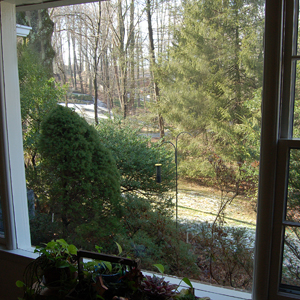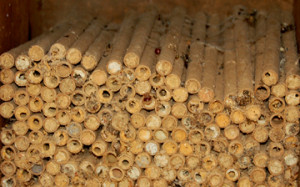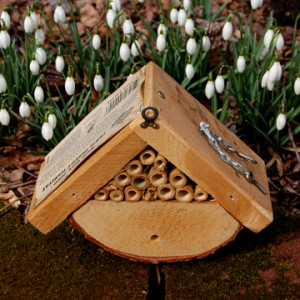View From
Rachel’s Window

Pesticides’ Risk to Bees in Europe & America
Although, today honey bees are used as commercial pollinators, this is a relatively modern development. Honey bees were originally brought to America from Europe in the 1600s to be honey producers. In the U.S. native bees functioned as natural pollinators up until the modern chemical pesticide era. When modern pesticides came into widespread use these chemicals decimated the populations of native pollinators. (Batra, S., “Hornfaced Bees for Apple Pollination,” 1998) Not far from Rachel’s window there is a small shed with a resident population of solitary bees. It is occupied by Japanese hornfaced bees, a gift from Dr. Suzanne Batra, (former director of USDA’s Beltsville Research Bee Lab).1 The bee shelter’s proximity to the house does not present a problem, since the hornfaced bees are essentially gentle and thus far have not stung any humans that they encounter. The hornfaced bees, as with most solitary bees, have no hive, no honey comb production and no colonial community. However, they are excellent pollinators, a trait shared with certain other solitary native bees. (Native wild solitary bees at one time numbered “some 17,000 species” worldwide) (Batra, S., “Solitary Bees,” Scientific American, Feb. 1984).
Although, today honey bees are used as commercial pollinators, this is a relatively modern development. Honey bees were originally brought to America from Europe in the 1600s to be honey producers. In the U.S. native bees functioned as natural pollinators up until the modern chemical pesticide era. When modern pesticides came into widespread use these chemicals decimated the populations of native pollinators. (Batra, S., “Hornfaced Bees for Apple Pollination,” 1998)
Although, today honey bees are used as commercial pollinators, this is a relatively modern development. Honey bees were originally brought to America from Europe in the 1600s to be honey producers. In the U.S. native bees functioned as natural pollinators up until the modern chemical pesticide era. When modern pesticides came into widespread use these chemicals decimated the populations of native pollinators. (Batra, S., “Hornfaced Bees for Apple Pollination,” 1998)

In their dorment stage, hornface bees occupy tubes in a shed/shelter. Adults emerge early in spring, are active for 3 months and return to produce the next generation.
European honey bees took up the slack. Today, however, they too are seriously threatened by heavy use of insecticides especially the neonicotinoids which are systemics-absorbed through the roots or by other means. (Systemics are chemical insecticides that can travel to all parts of a plant, including pollen and nectar.) Rachel Carson wrote: “…the world of systemic insecticides … .is where a bee may carry poisonous nectar back to its hive and presently produce poisonous honey.” (Carson, Silent Spring, p. 33.) Note: No chemical pesticides are used on the Rachel Carson House grounds to assure the health of resident wildlife.
Neonicotinoid insecticides have been linked to serious reductions in populations of honey bees by scientists here and abroad.European honey bees took up the slack. Today, however, they too are seriously threatened by heavy use of insecticides especially the neonicotinoids which are systemics-absorbed through the roots or by other means. (Systemics are chemical insecticides that can travel to all parts of a plant, including pollen and nectar.) Rachel Carson wrote: “…the world of systemic insecticides … .is where a bee may carry poisonous nectar back to its hive and presently produce poisonous honey.” (Carson, Silent Spring, p. 33.) Note: No chemical pesticides are used on the Rachel Carson House grounds to assure the health of resident wildlife.European honey bees took up the slack. Today, however, they too are seriously threatened by heavy use of insecticides especially the neonicotinoids which are systemics-absorbed through the roots or by other means. (Systemics are chemical insecticides that can travel to all parts of a plant, including pollen and nectar.) Rachel Carson wrote: “…the world of systemic insecticides … .is where a bee may carry poisonous nectar back to its hive and presently produce poisonous honey.” (Carson, Silent Spring, p. 33.) Note: No chemical pesticides are used on the Rachel Carson House grounds to assure the health of resident wildlife.
- French researchers found that honey bees exposed to the neonicotinoid-laced sugar water were 31% less likely to return to their home hive in unfamiliar territory. (Henry, M., et al., “A common pesticide decreases foraging success and survival in honey bees,” Science, 3-29-12 online)
- British researchers found that bumble bees exposed to a neonicotinoid-laced sugar water produced 85% fewer queens. (Whitehorn, P.R., et al., “Neonicotinoid pesticide reduces bumble bee colony growth and queen production,” Science, 3-29-12, online)
- American researcher Dr. Jeff Pettis is “convinced that neonicotinoids in low doses make bees more vulnerable to disease.” (Zimmer, C., “2 studies point to common pesticides as a culprit in declining bee colonies,” NYT, 3-29-12)
In January 2013, the European Food Safety Authority (EFSA) released Risk Assessment Reports for 3 neonicotinoid insecticides, imidacloprid, clothianidin and thiamethoxam showing that these chemicals pose a clear hazard to honey bees. (“Neonicotinoids do harm bees, finds, EFSA,” Pesticide & Chemical Policy, 1-16-13)
In their report the EFSA scientists reached these 4 conclusions:
- Given the potential harm to bees from exposure to neonicotinoid-contaminated pollen and nectar, “only [neonicotinoid insecticide] uses on crops not attractive to honey bees were considered acceptable.”
- Given the potential exposure of bees to the dust generated at the time of planting seeds, “…a risk to honey bees was indicated or could not be excluded.”
- For the fluid (droplets emerging from plants and used by bees for liquid) accumulating on maize treated with thiamethoxam, studies “…show an acute effect on honey bees exposed to the [neonicotinoid] substance through [this] guttation fluid.”
- Data on the effects of neonicotinoid insecticides on pollinators other than honey bees appears limited and needs to be investigated. (“Neonicotinoids do harm bees, finds, EFSA,” P&CP, 1-16-13)
A European Action – Shortly after the EFSA released its risk assessment reports indicating serious problems for bees exposed to neonicotinoid insecticides, the European Commission approved a two-year partial ban on imidacloprid, clothianidin and thiamethoxam, the neonicotinoid insecticides applied to crops that attract honeybees. (“EC approves a partial ban on neonicotinoids,” P&CP, 2-1-13)
An American Action – Subsequent to the European ban announcement, the USEPA announced a Pollinator Summit to be held on March 5, 2013 in conjunction with the USDA “…to collaborate on activities to protect honey bees and other pollinators from pesticide risks.” (http://www.epa.gov/oppfead1/cb/csb_page/updates/2013/pollin-summit.html)
Note: The European Commission’s decision to impose a partial 2-year ban on the 3 neonicotinoid insecticides (imidacloprid, clothianidin and thiamethoxam) for crops where bees are likely to contact them is appropriate given the EFSA reports’ conclusions as well as the essential role played by bees in our food supply.
The European Commission is to be applauded for enacting the partial ban.
The USEPA is to be commended for responding to the European regulators’ ban by announcing a Pollinator Summit that is open to the public.
Of course, holding the Summit does not equate with the European action of imposing a partial ban on the three insecticides for 2 years. It does, however, give environmentalists and others a forum where they can support greater protection for bees.
It would be wonderful for the EPA to follow the European lead by adopting a similar ban here in the US for the 3 neonicotinoids: imidacloprid, clothianidin and thiamethoxam. Our regulators, however, should go further and provide enhanced protection from toxic chemicals for bees on the plants (of horticulture and agriculture) that they visit regularly. This could mean eliminating use of any systemic insecticide on plants that attract bees. Thus native bees, as well as the European honey bees could begin to rebound from the debilitating contamination that has curtailed their ability to perform important pollination services that they do so well.
Diana Post
NOTE:
Subsequent to the writing of this report, a vote was taken on the EC’s proposed partial ban on neonicotinoid insecticides to protect bees. The results were inconclusive. The member nations have two months to work out a compromise. If none is “reached within 2 months, rules provide for the EC to act on the proposed ban.” (Pesticide and Chemical Policy 3-15-13)
1 First propagated in Japan to pollinate apples, pears, peaches and plums, hornfaced bees were imported into the US and studied by Dr. Suzanne Batra at the Beltsville, MD Lab. Their reproductive process involves the female’s building her own brood cells (about 10), stocking the cells with food for the young, and laying an egg in each cell. These cells can be found in naturally-occurring wood crevices or in cardboard tubes 1/4 inch in diameter available for commercial propagation of hornfaced and certain other solitary bees.
For past View from Rachel’s Window articles click here


